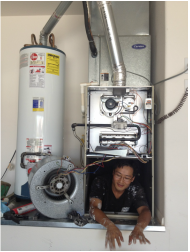This is more than a marketing and advertising plan. This post can help you avoid their mistakes and try new things and if you get nervous thinking about trying something new, it's probably something worth your full effort.
What is the difference between successful independent energy auditors and energy auditors that go out of business?
A willingness to do whatever it takes
I mentor a new energy auditor who started his own independent energy audit business. He is qualified with lots of experience and over 1,000 audits under his belt and does a good check up, is personable and has good customer service skills. We had talked about getting new business by acting as an independent energy auditor to home performance contractors in our Home Performance With Energy Star Program. He would have to call each contractor and solicit his energy audit services highlighting his independence and ease of gaining trust with homeowners, experience in the Energy Star program and flexibility and adapting to each companies process and requirements. He would have already set a set schedule of availability, how much he would charge per audit and what deliverables and services he would provide. That was all set so after a week of quitting his existing job, we met and I asked how his process was going? He replied that he hadn't called anyone yet. We were providing most of his leads thus far on overflow audits we had but I knew that it was going to eventually dry up and he would be up a creek if he didn't act fast. After discussing the inevitability it was clear his lynch pin was that he was very hesitant on picking up the phone and calling anyone. Cold calling is intimidating and scary, but what is more scary is not having any money in the bank account to feed the kids! This guy needed to get on the phone and start dailing, knocking on doors, connecting with managers on LinkedIn, showing up at home shows and introducing himself, writing letters and take massive action to put himself in front of companies. I knew his service was needed, he just needed to take the jump and put himself out there everyday.
That's where a lot of companies fail, they won't do anything that makes them uncomfortable and so when one marketing source dries up, they have nothing to fall back on to keep the money flowing in. A marketing plan is only as good as its implementation and back end execution. Too many energy auditors aren't willing to do what makes them uncomfortable out of fear of rejection, being seen as pesky and annoying, and because of the negative connotations surrounding the action. I heard on my local news talk radio show during their news round up that any door to door sales people should be avoided because that way of marketing is outdated. I thought that was a stupid and ignorant thing to say that just makes it harder for companies to do what they do. Yes, there are companies that do door to door sales that are crooks but there are also ethical companies that offer good products and services that do door to door sales. That mindset of being an annoying pest keeps many energy auditors out of the game and leaving thousands of dollars on the table. If you practice ethically, there is no reason why you should be hesitant in promoting your energy audit services in any way possible. Energy auditors offer a service that is needed by the public and with a clean conscious you have given yourself the green light to promote yourself to the masses.
Are there times you will have to do things that take you out of your comfort zone? Sure, but the more you practice and build up your "muscles" the easier it gets and the more effective you get. Don't become paralyzed in a state of inactivity or comfort.
Will you maybe not hit the mark every time and have to go back to the drawing board to alter course? Maybe, but an imperfectly executed plan is far better than a perfectly planed non executed plan.

 RSS Feed
RSS Feed